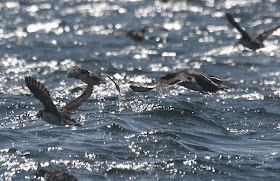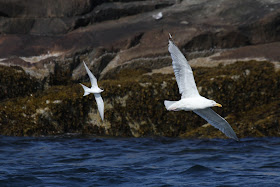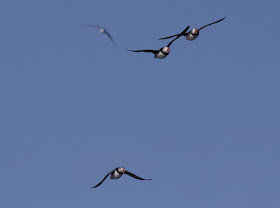Part 2- Sunday afternoon, meeting John Drury, and (hopefully) the Red-billed Tropicbird
Back in April when I first contacted John, the idea came to me to carve a Red-billed Tropicbird decoy with the idea being to possibly photograph the bird with or near my decoy. Without being too presumptuous of course, maybe the bird wouldn’t show up this year, or assuming that it did, would it even get close enough to the decoy to take a picture? I had never carved a Red-billed Tropicbird before. I did however carve a White-tailed Tropicbird decoy for a fundraiser.
The thought of carving a Red-billed Tropicbird decoy was exciting to me, so I did. The bird is hollow-carved from tupelo wood, and the inserted tail streamer is carved from Sapote (Manilkara bidentata) a very strong wood from the Caribbean and Central America-
Since this species is common in the Caribbean, I decided to compliment its features with two Caribbean wood species: the bottom wood insert plate is Caribbean Tamarind
(Tamarindus indica), and the carved keel is carved from Black Poison Tree wood (aka Caribbean Rosewood) – (Metopium brownie) one of the most beautiful woods in the Caribbean -
Painting the finishing details-
The finished decoy ready to float-
John told Jen and I to meet him at the town landing at 2:00 pm. Of course we were quite anxious to go. We spent the morning driving around the Island finding all the Nature Preserves, and just enjoying the solitude of this beautiful Island . At noon we were sitting on our deck watching the busy harbor as lobster boats came in and out with more regularity than the car traffic on the Island (which there isn’t too much of). The wind was blowing in from the Southwest at fifteen to twenty-five and gusty. The flags were standing straight out, and I wasn’t sure if we would get out at all. I was obviously fidgeting with the camera bag, boat gear and the decoys making sure I had packed everything; I was anxious to get going! Jen smiled a bit knowing the turmoil that was going on inside me. I kept watching the clock until Jen said, let’s go down to the town dock, maybe John will come early?! We arrived an hour early and ended up sitting on the bench at the ferry building having a wonderful conversation with a local gentleman. He told us all about the history of Vinalhaven, and the time passed quickly.
On the end of the town dock, a few people had been fishing for Snapper Blues, and they soon left with a bucket full of small Bluefish. We took our gear to the end of the dock, and I took up my usual activity when waiting for a trip to begin: pacing! I remembered what John had told me in our emails that the Tropicbird kept a very regular schedule; it would usually show up around 4:00 pm in the afternoon, and remain in the area for as little as a few minutes to as long as an hour. John’s boat is a thirty-four foot Lobster boat named Fluke. Jen and I looked at every boat coming in the Harbor, and suddenly, there he was. I had also been concerned that maybe it would be too rough to go out. Since there wasn’t any reliable cell power on the Island , he didn’t have any way to contact me in the event that he would be cancelling. Than it occurred to me, he could call Phil at the Motel to let us know. But I wasn’t sure, maybe he would tell us at the dock?
As the Fluke pulled up to the dock, it was a handsome vessel; proud at the bow and beamy. John carefully guided the Fluke to the dock, and his hand extended out from the helm; “Keith”? I returned the handshake and introduced myself. Jen was on her way down the dock with additional bottles of iced bottled water, and she introduced herself to John. With our gear and both of us on board, John backed the Fluke out, and we headed out the channel of Carvers Harbor
Underway, we talked of seabirds, lobstering, living on Vinalhaven, family, travel, and even how he named Fluke hearing just enough of the conversation over the rumbling of the diesel to make sense. As we passed a small island, John pointed starboard and said “Alfred Hitchcock”. Jen and I looked and suddenly there he was! On the southern tip of one of these islands, a rock formation clearly formed the profile of Alfred Hitchcock-"Good Evening"!!
Black Guillemots were scattered throughout the area along with small groups of Common Eiders and Terns. As we passed between Big Roberts and Little Roberts Islands, John began telling us of the Great Cormorant colony that had been nesting there for many years and he has been studying (more details later in the report). In fact this colony was one of only four nesting colonies in the area, and the only nesting colony in the
We did see many Gannets crossing behind the stern-
John told me that it took three and a half hours for a round trip from the town dock to Seal Island Seal Island
The Fluke settled a bit as the quiet of the lee tamped down the rolling sea. It was easy standing now on the deck of the Fluke not being tossed from side to side like a steel ball in a pinball machine. As John skirted the edge of Seal, he pointed to all the attractions the Island has to offer including pointing out the location of the Tropicbird’s burrow. John told us that the bird spends most of the day in its burrow returning after a brief morning feeding foray on the open sea. The Tropicbird usually came out of its burrow in the afternoon, and appears quite regular from 4:00 to 5:00 pm at the latest. John felt we still had a bit of time, so we made a quick pass along the Islands north and northeast shores.
Jen and my first impression was eye opening! The bird activity was overwhelming. The Terns wheeling flights over the Island was breathtaking, and noisy with all the Tern chatter! Jen and I soon realized, we had found seabird heaven! I told that to John, and he simply smiled and nodded; he agreed!
Besides the steady stream of Terns to and from the Island , the next birds we saw were Common Eiders as this eclipse drake, and small groups (below)-
As we neared the northeast tip of the Island , Puffins and Guillemots were everywhere; both flying in and out and swimming. In fact there were so many birds, you didn’t know which way to look. So we concentrated on the birds on the water near the Fluke. John approached the Puffins and Guillemots slowly and carefully often maneuvering the Fluke within a few yards of the birds-
There were a few Razorbills mixed in with the Puffins-
This Razorbill was banded-
Many of the Puffins were standing on the top boulders on the Island . This group had a single Razorbill mixed in-
An immature Common Tern picks up a small piece of weed on the surface…..
Well, let’s look at it again!
When John rounded the northeast point of Seal
…..including this one Common Murre-
The numbers of Puffins increased and they were all around the boat-
A single Great Cormorant flew by-
John returned to the leeside cove on the north side of the Island figuring it was nearing time for the Tropicbird to (hopefully) make its appearance. John selected the best spot to put my Tropicbird decoy, and we tossed it over the side. The decoy floated perfectly, how can the Tropicbird refuse?
The Fluke was tied off to a buoy and we sat quietly waiting for the bird. Of course sounds of swirling Common and Arctic Terns filled the air, competing with my camera’s shutter as I was taking pictures of birds in all directions. John is a fabulous seabirder, he can pick out the Arctic Terns from the Common Terns in the distant flocks as easily as selecting red jelly beans in a jar-
Small flocks of Semi-palmated Sandpipers flew into the Island from the North-
The Tern show continued-
This Arctic Tern was a bit distressed with my Tropicbird decoy; it swooped at it twice before flying off-
Common Tern-
Interesting flying maneuver; rubbing its head on its wing while flying-
Black Guillemots were common around the Island both swimming and flying. This one came flying in with either a Sandlance or Needlefish-
Razorbills traded once and a while-
John’s eyes searched the air, but the Tropicbird was still a no-show. I decided to have a bit of fun with the Puffins and Guillemots. I suggested we set the Puffin, Razorbill and Guillemot decoys off the stern. As I started taking the decoys out of the trunk box carrier, John picked up every one of them and looked them over good. I really appreciated John admiring my decoys. I also brought along the Greater Shearwater and Pomarine Jaeger decoys; just in case. John was excited to see both of them and he handled them like he was admiring a fine art sculpture. I learned another thing about John; he really likes Jaegers!
The alcid decoys were sent off the stern and they drifted with the tide to the end of the mainline; about twenty-five yards. I secured the mainline to the cleat, and they floated proudly on the sea. Now all we had to do was wait. -
While John, Jen and I were chatting, a commotion came over the Tern colony and a huge swarm of chattering Terns filled the sky off the northeast point. Could it be the Tropicbird? John told us that the Tropicbird appeared to be amused by harassing the Terns on the Island . As the Terns drew closer, it was obvious what stirred them up-
It wasn’t the Tropicbird, but a Herring Gull. It had stolen a young Tern from a nest, and the Terns were chasing it!-
The Herring Gull flew towards us, revealing its macabre prize all the while Terns were perusing it-
The Gull landed on a rock closer to us and consumed its meal.
As the Gull took off, another Tern announced its disapproval at the Gulls action. The Tern chased the Gull, and as we looked at the Tern, we discovered it was a Roseate! Since there were only one or two pairs nesting on the Island amongst the several thousand Common and Arctic Terns, we were fortunate to see it-
This Common Tern landed right next to my Tropicbird decoy and suddenly scooped up a Herring-
Another Black Guillemot flies by with this unidentified fish-
This Puffin landed near the boat……
Hey! Get in line!-
Puffins began landing on the boulders behind the Fluke-
A high-flying Black Guillemot with another unidentified fish-
More Puffins flying right into the decoys. Now my decoys really have a story to tell!-
Arctic and Common Terns-
One of the few Laughing Gulls visiting Seal Island-
As the afternoon wore down, I was beginning to wonder if the Tropicbird would show! Suddenly the Tern Colony was stirred-up again, could it be the Tropicbird?
Unfortunately, a Greater Black-backed Gull flew over the colony and was promptly escorted out!
John seemed a bit disappointed (as Jen and I were) and said that it was too late for the Tropicbird, it was a no-show. He talked to a biologist on the island on his radio and they mentioned that they didn’t see the bird that day either, and only saw it briefly the day before on Saturday. It was hard to leave the area, but it was getting late and we still had a long ride in. But the low sun was perfect for pictures. I hauled in my decoys and left them on the stern. With the Fluke untied from its buoy, we crept along the shoreline taking full advantage of the light and the birds!-
This one Puffin in the back is just “popping-up” from a dive; you can see its head forming a bubble as it breaks the surface of the sea-
Just as we passed the northeast point of the island, a single Wilson
John was just starting to throttle-up when he called out, “Keith, a Murre”! He pointed just off the starboard bow. He backed off the throttle, and crept towards the Common Murre. The bird was stunning, appearing to be plumed in soft Brown velvet, a generous gift from the late afternoon sun. John and I started taking pictures of the bird. As the Murre got closer to the Fluke, my shutter finger was very busy. And it never fails, just as the bird was only a few yards from the vessel, my camera stopped revealing the flashing “card full” warning in the view finder. I couldn’t believe it! But with great speed, I changed cards in record time, just in time to take a few frames of images of the Murre just as it pattered across the sea. What a spectacular bird!
When we passed the outer lee of the
Leaving Seal Island-
Three Razorbills fly north towards
After a short run, John spotted a Shearwater crossing out from the starboard. He exclaimed “Cory’s- which was a rare Shearwater for these waters-
Plenty of Gannets to see on the ride home to port-
Within minutes, a second and a third Cory’s appears off the starboard side-
Laughing Gulls head back to
The Wilson
After nearly forty-five minutes of cruising, John guided the Fluke within the outer rim of islands. He told us about the Eagle roost on Otter Island Maine Islands has also dramatically increased as well.
This image isn’t of any significance; I just like the look of the formation in the rock face. I love the natural sculpture this rock face exhibits. (Can’t help it- it’s the artist in me)!
When John steered the Fluke to the leeside of Otter Island
We got back to the town dock just before sundown, and what a day it was. Although Jen and I were disappointed that the Tropicbird didn’t show up, we were confident that it would be there tomorrow afternoon. Even with the no-show Tropicbird, the amazing seabird show at Seal Island
As I was packing up our gear ready to offload, John enjoyed my Tropicbird decoy to end the day. Thanks John, we had an unbelievable day; see you tomorrow afternoon!
The Fluke and dory in tow, heading to Greens Island-
Highlights for Sunday, July 22 (approximated)- 300 Puffin, 60 Black Guillemot, 8 Razorbill, 3 Common Murre, 400 Common Tern, 50 Arctic Tern, 1 Roseate Tern, 45 Laughing Gull, 5 Short-billed Dowitcher, 35 Semi-palmated Sandpiper, 1 Whimbrel, 11 Osprey, 16 Bald Eagle (both including birds in town earlier in the day), 15 Great Cormorant, 100 Double-crested Cormorant, 40 Northern Gannet, 16 Wilson’s Storm-Petrel, 4 Greater Shearwater, 3 Cory’s Shearwater, 100 Common Eider, 3 Black Duck.
Town Dock in
Seal Island NWR satellite view-
Seal Island NWR Tern nesting colony survey chart-
Seal Island NWR- Fluke was tied off here (green arrow) and the largest concentrations of Puffins were around the northeast point (red arrow)-
Bald Eagle roost (orange arrow)-
Part 3- "The Quest for the Red-billed Tropicbird" continues- click on “Older Posts” below right.


























































































































































































































































